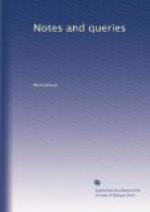W.J.
Havre.
English Translations of Erasmus’ “Encomium Moriae" (Vol. i., p. 385.).—Perhaps JARLZBERG, who seems interested in the various translations of this admirable work, might like to know of a French translation, with designs from Holbein, which I purchased some weeks ago at a sale in a provincial French town. It is entitled L’Eloge de la Folie, compose en forme de Declaration par Erasme, et traduit par Mr. Guendeville, avec les Notes de Gerard Listre, et les belles Figures de Holbein; le tout sur l’Oiginal de l’Academie de Bale. Amsterdam, chez Francois l’Honore. 1735.
W.J.
Havre.
Lady Slingsby (Vol. ii., p. 71.).—She was a professional actress, who played under the name of Mrs. (probably Miss) Mary Lee, from about 1672 to 1680, after which date she is called Lady {94} Slingsby, and she played under this title for about five years, when she seems to have quitted the stage. She survived her husband, for “Dame Mary Slingsby, widow, of St. James’s parish, was buried at Pancras, 1st of March, 1694.”
C.
Meaning of “Bawn" (Vol. i., p. 60.).—The poet Campbell uses the word bawn as follows:—
“And fast and far, before the star
Of day-spring, rush’d we through
the glade,
And saw at dawn the lofty bawn
Of Castle-Connor fade.”
O’Connor’s Child.
ROBERT SNOW.
Chantrey’s Sleeping Children (Vol. ii., p. 70.)—Your correspondent PLECTRUM is anxious to know on what grounds I attribute to Stothard any part of the design of the monument in Lichfield Cathedral known as Chantrey’s “Sleeping Children?” I will endeavour to satisfy him.
The design, suggested, as it were, by the very nature of the commission, was communicated by Chantrey to Stothard with a request that he would make for him two or three sketches of sleeping children, at his usual price. What Stothard did, I have heard my father say, was very like the monument as it now stands. The sketch from which Chantrey wrought was given to me by my father a few months before his death, and is now suspended on the wall of the room in which I write.
It is a pencil-sketch, shaded with Indian ink, and is very Stothard-like and beautiful. It wants, however, a certain sculptural grace, which Chantrey gave with a master feeling; and it wants the snow-drops in the hand of the younger sister,—a touch of poetic beauty suggested by my father.
The carver of the group (the person who copied it in marble) was the late Mr. F.A. Lege, to whom the merit of the whole monument has been foolishly ascribed.
I should be sorry to impress the world with the belief that I mean in any way to detract from the merit of Chantrey in making this statement. I have divulged no secret. I have only endeavoured to explain what till now has been too often misunderstood.




